Convert Your Shoes Into a Comfort Zone: 10 Best Insoles for Sciatica
You’re not alone if you’re grappling with the relentless aches and discomfort of sciatica. Sciatica is a condition. It is characterized by pain that radiates along the path of the sciatic nerve. It starts in your lower back, goes through your hip, and travels down each leg. Millions of people worldwide are affected. However, there is good news: the right footwear, specifically insoles, can play a crucial role in managing and alleviating your pain. In this blog post, we will delve into the best insoles for sciatica. We’ll also explain how they can provide the relief you’ve been yearning for.
What is Sciatica
In basic terms, sciatica refers to pain. It radiates along the path of your sciatic nerve. The sciatic nerve begins at your lower back and branches down the hips, buttocks, and each leg. It’s typically felt on one side of the body, depending on which side the sciatic nerve is affected.
But sciatica isn’t a standalone medical condition. Instead, it’s a symptom of an underlying issue. It’s the body’s alarm system. It indicates that something is wrong and puts pressure on the sciatic nerve.
Why Does Sciatica Happen?
Sciatica commonly occurs due to a herniated disk. It also happens because of spinal stenosis, which is a narrowing of parts of the spine, and a bone spur on the spine. In some rare cases, it happens due to a tumor.
Herniated Disk
A herniated disk happens when the soft jelly-like center of a spinal disk pushes through a crack in the exterior casing. This can cause irritation and pressure on the sciatic nerve, leading to pain.
Spinal Stenosis
Spinal stenosis is a condition when the spinal column narrows. This puts pressure on the nerves. This is commonly due to osteoarthritis building up in the spinal canal.
Bone Spurs
Bone spurs, or osteophytes, are hard bumps of extra bone that form around the edges of bones. If these develop on the vertebrae in your spine, they can press on the sciatic nerve. This causes sciatica pain.
Pain Points Related to Sciatica
Understanding and identifying your sciatica pain points are crucial. They help manage the condition effectively. These pain points generally include:
Lower Back Pain
Despite the sciatic nerve extending down the leg, the primary pain point for sciatica sufferers is often the lower back. Intense sharp pain, dull aching, or even a burning sensation can often be felt in this area.
Hip Pain
The sciatic nerve runs very close to the hip joint. As a result, irritation or pressure on the sciatic nerve can lead to pain in the hip.
Leg Pain
The hallmark of sciatica is leg pain. It’s often described as a burning, searing, or sharp sensation. It can run down the entire length of the leg, from the buttock to the foot.
Understanding the pain points of sciatica is pivotal. Identifying them is crucial for finding appropriate treatment and relief methods.
How Insoles Easing Sciatica Symptoms

Insoles, also referred to as foot orthotics, are inserts that can be placed inside your shoes. They offer extra support to your feet. This helps to distribute weight evenly, correct imbalances, improve alignment, and provide comfort.
Insoles are not a cure for sciatica. However, they can be part of a comprehensive strategy to manage the condition. But how exactly do they work to alleviate the pain associated with sciatica?
- Improving Alignment and Posture
Insoles can help alleviate sciatica pain by improving body alignment and posture. Misalignment in your feet can lead to irregular walking patterns, also known as gait. This can cause an uneven distribution of weight. This imbalance can ripple upwards through your body. It can lead to pressure on your lower back. It contributes to sciatica pain. Insoles provide proper arch support and promote a more natural foot placement. This can promote better overall body alignment and reduce nerve compression.
- Absorbing Shock
Feet endure a tremendous amount of pressure throughout the day. They absorb the shock of each step we take. This impact can travel up the body, exacerbating issues like sciatica. Insoles, especially those having cushioning or gel components, act as shock absorbers. They help dissipate the force of your steps. This reduces strain on lower back muscles. It also lessens potential irritation on the sciatic nerve - Reducing Pronation
Excessive foot pronation occurs when feet roll inwards excessively. This can contribute to misalignment in the lower back. This can aggravate sciatica symptoms. Insoles designed to prevent overpronation can help keep your feet in proper alignment. This can minimize lower back strain.
What Makes a Good Insole for Sciatica?
Struggling with sciatica can be a burdensome ordeal. The radiating pain stems from the lower back and streaks down the leg. It often restricts daily activities. Fortunately, a seemingly small change, like integrating insoles into your footwear, can make a sizeable difference. When selecting insoles, focus on key criteria such as support, comfort, material, fit, and user reviews. It’s paramount to ensure that you’re choosing the most effective insole. This blog post will guide you through essential elements to consider when choosing the best insole for sciatica.
1. Support
When discussing insoles for alleviating sciatica, the aspect of support is vital. The prime objective of any good insole is to offer exceptional arch support. Insoles should help maintain the foot’s natural shape.
They should distribute body weight evenly, reducing stress on the lower back. For those with flat feet or high arches, specialized insoles can provide much-needed balance. Moreover, a deep heel cup is another crucial feature. It promotes better foot alignment, aiding stability. It also helps ease sciatica pain.
2. Comfort
It might be tempting to choose an insole that provides maximum support. However, it’s equally important to make sure it doesn’t compromise on comfort. Insoles must feel comfortable during extended periods of wear.
Look for an insole that matches the contours of your foot. This prevents discomfort and pressure points. Also, remember that it might take a bit of time for your feet to adapt to the new support. They shouldn’t cause outright pain or extreme discomfort.
3. Material
The materials used in an insole can have a profound impact on both comfort and durability. Memory foam or gel insoles are known for offering excellent cushioning effect. They effectively absorb shocks and reduce the pressure triggered by each step. Cork or harder plastic, on the other hand, might provide more rigid support where necessary. Therefore, choose a material that aligns with your specific comfort and support needs.
4. Fit
A helpful insole fits perfectly inside your shoes without cramping your feet or making your shoes overly tight. It should snugly fit the length and width of your shoe’s interior. A poorly fitted insole will likely cause more harm than good.
It can lead to discomfort, imbalanced support, and potentially make sciatica pain worse. Insoles often come in different sizes; make sure to pick the size that matches your footwear.
5. User Reviews
Before making your purchase, check user reviews. They can offer insight into a product’s effectiveness. You should always consult a healthcare professional for personalized advice. User reviews can give you a realistic expectation of the insole’s performance. Look for reviews that mention the insole’s comfort, effectiveness in relieving pain, durability, and any potential drawbacks. It’s beneficial to do some research and make an informed decision.
10 Best Insoles for Sciatica Pain Relief
Living with sciatica can be a challenge. However, one of the best ways to manage the discomfort that comes with this condition is by using the right insoles. We’ve put together a carefully curated list of the 10 best insoles for sciatica pain relief. It includes reviews, key features, and the advantages and drawbacks of each.
ComfortMax Insoles for Long-Lasting Pain Relief
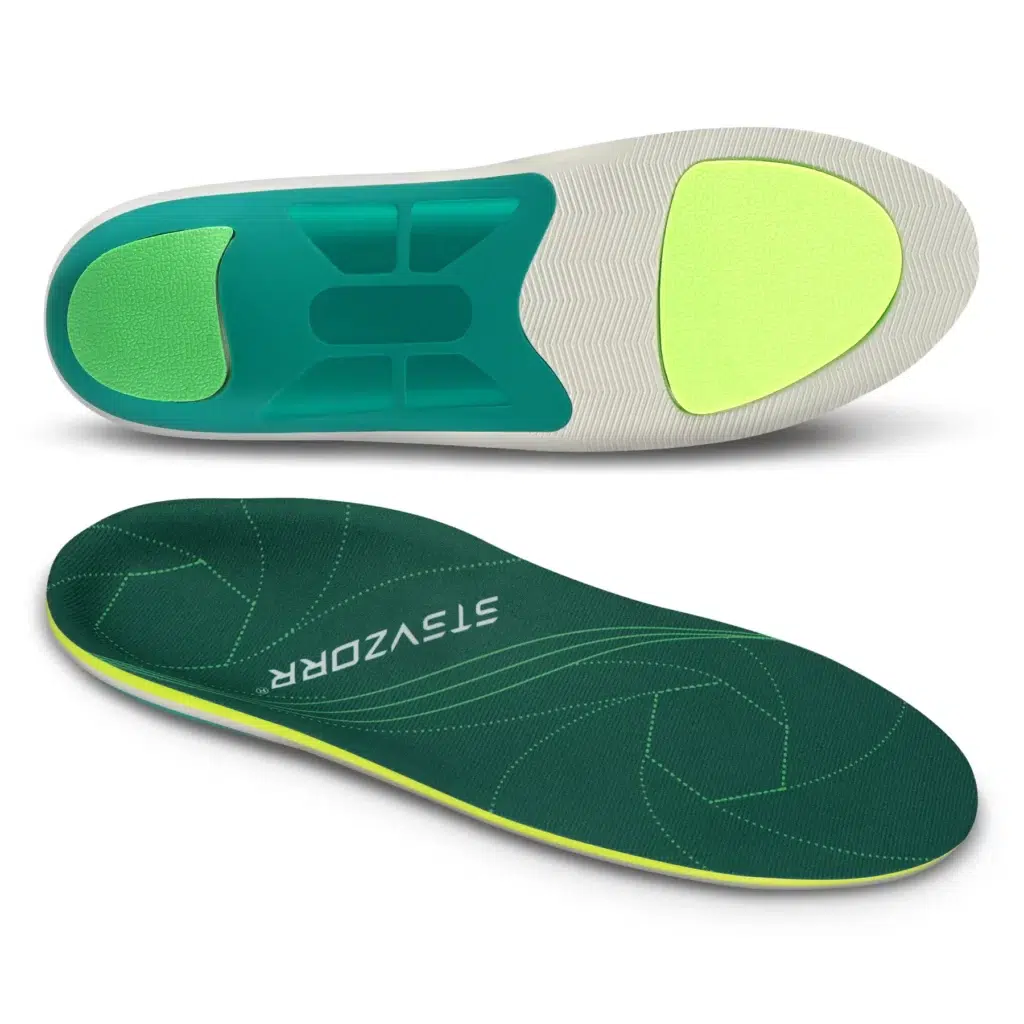
ComfortMax Insoles seamlessly blends comfort, support, and durability. Memory foam molds to your foot, providing optimum support and comfort. It also redistributes pressure and absorbs shock. This can drastically reduce sciatica symptoms.
Pros:
Provides excellent support
Built to last
Promotes correct foot alignment
Efficient pressure redistribution
Impressive shock absorption
Cons:
Might not fit perfectly in all types of shoes
Can take some time to break in
Premium Orthotic High Arch Support Insoles

Premium Orthotic Insoles offer comfortable support and targeted pain relief for sciatica sufferers.
Premium Orthotic insoles use a unique blend of foam and gel. They offer unparalleled pressure redistribution and shock absorption, ideal for managing sciatica pain.
Pros:
Proprietary blend of materials provides extra comfort
Highly durable with robust construction
Excellently disperses pressure across the foot
Effective in shock absorption
Cons:
Can be a bit thicker for some types of shoes
The unique foam/gel combo may not suit every user’s preference
CURREX SUPPORTSTP Unisex Shoe Insert

CURREX SUPPORTSTP is recognized for its precise support and pain relief. The soft gel material has pressure redistribution features. It reduces discomfort in the pressure points. It absorbs impact and maintains the correct alignment, significantly easing sciatica symptoms.
Pros:
Precise and comfortable fit
Made with durable, long-lasting materials
Promotes good foot health
Efficient in relieving pressure points
Remarkable shock absorption
Cons:
May not offer enough arch support for some users
Might be too soft for those used to firmer insoles
Superfeet Hike Support Insoles
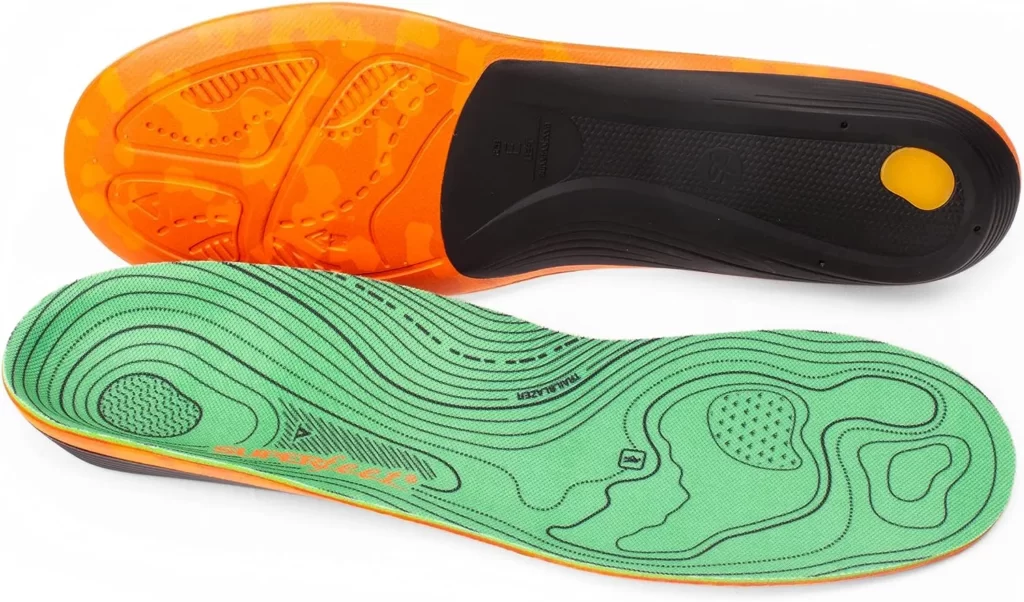
Superfeet Hike Support Insoles offers unmatched comfort and adaptable support. It is a top choice for those with sciatica. Its multi-density foam provides excellent pressure point relief. Its shock absorption capacity helps reduce impact. It offers substantial relief to those suffering from sciatica.
Pros:
Provides great adaptability to various foot shapes
Offers personalized comfort with customizable support
Durable and wear-resistant material ensures longevity
Easy to clean and maintain
Cons:
Can be priced higher than some other options
The right fit can be challenging at first
JobSite Heavy Duty Boot Support Insole
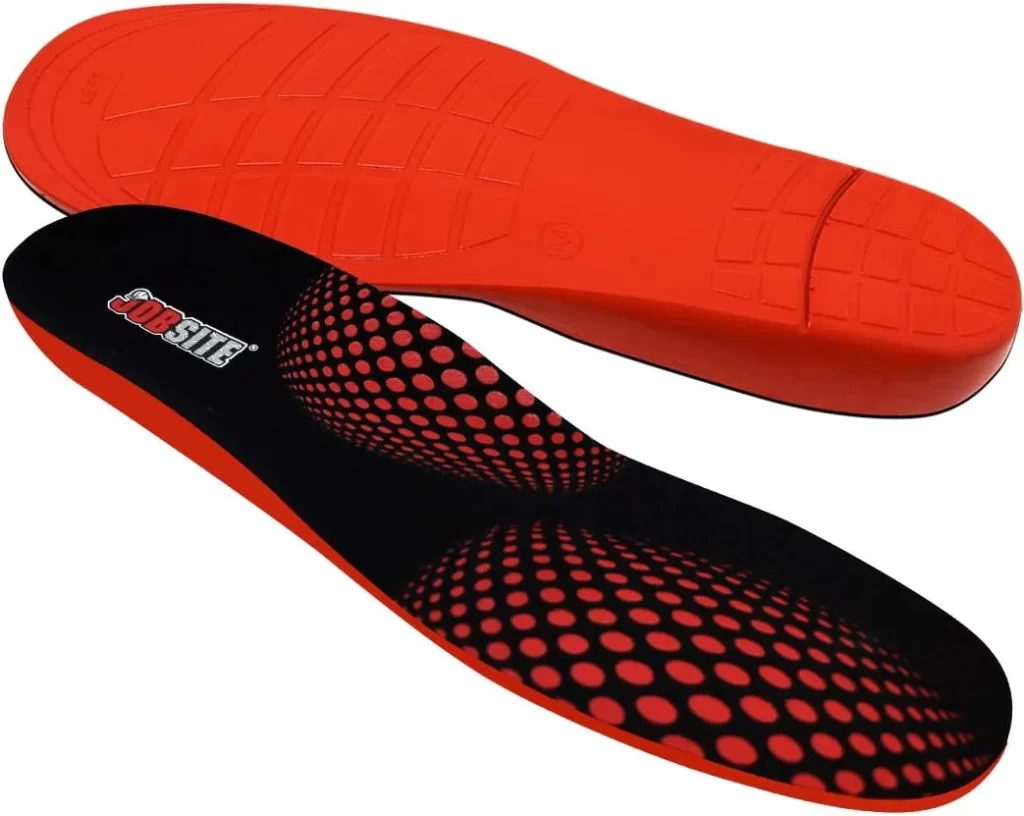
JobSite Insoles stands out due to its advanced design. It’s specifically aimed at relieving sciatica-related discomfort.
JobSite Insole’s dual-density foam along with structural support targets specific pain points, providing significant relief from sciatica symptoms. It optimizes pressure redistribution and absorbs shock effectively.
Pros:
Suitable for various types of arches
Perfect for daily wear and prolonged use
Easy to insert and remove from shoes
Durable material ensures long-lasting use
Cons:
Some users may require a break-in period
Might not comfortably fit in narrow shoes
Walk-Hero Insoles Men’s ATHLETE Insoles

Walk-Hero Insoles distinguishes itself with a design perfect for those seeking targeted relief and premier support.
Walk-Hero significantly mitigates sciatica symptoms with its superior pressure distribution and shock absorption features. The soft latex foam offers enhanced comfort and support.
Pros:
High level of comfort and support
Durable, built to last
Excellent pressure redistribution
Advanced shock absorption capabilities
Cons:
Some users may find the insole too soft
A break-in period may be necessary
Copper Fit Unisex Work Gear Comfort Insoles
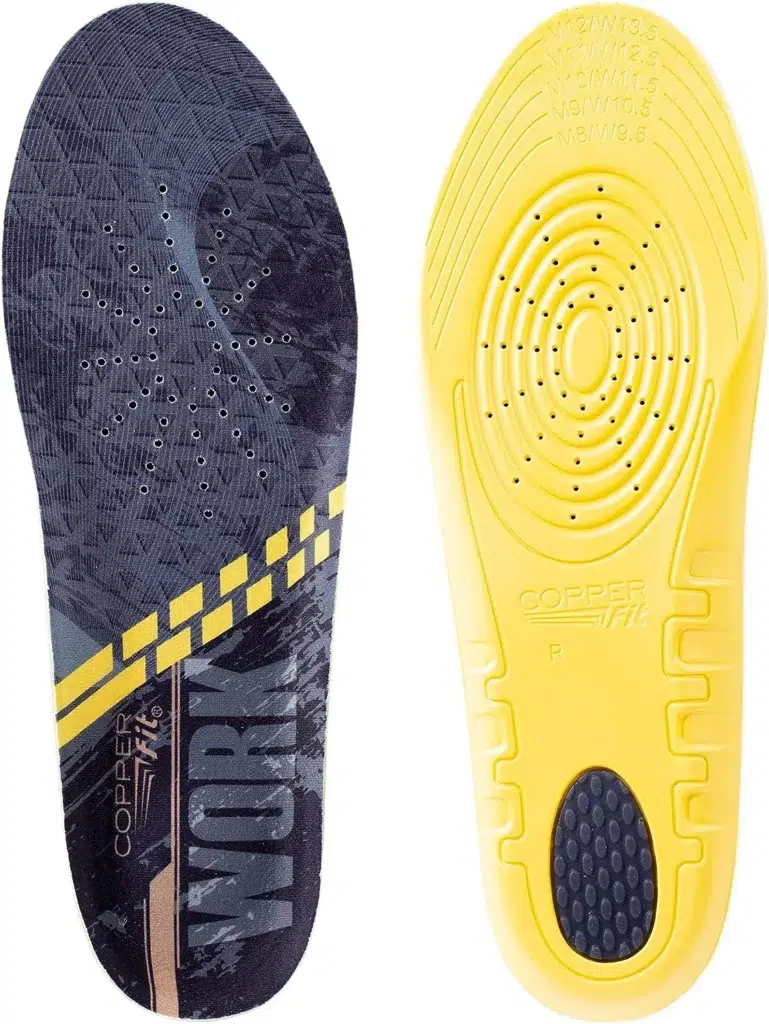
Copper Fit Insoles is renowned for its exceptional pain relief and notable comfort. They are particularly suitable for sciatica sufferers.
Copper Fit’s high-quality EVA foam construction offers comfort and support. It relieves pressure points and absorbs shock. This significantly reduces sciatica symptoms.
Pros:
Durable design built for heavy use
Great pressure redistribution and shock absorption
Efficiently corrects foot alignment
Cons:
Might take some time to mold to the foot’s shape
Might require more room in tighter shoes due to thickness
Vionic Unisex Insoles

Vionic Unisex Insoles is praised for its advanced technology. It’s designed to alleviate discomfort and promote foot health.
Vionic Unisex Insoles combines memory foam and gel cushioning. This delivers exceptional comfort, superb pressure point relief, and efficient shock absorption. It is ideal for those battling with sciatica.
Pros:
High-end materials deliver exceptional comfort
Built for long-term use
Efficiently redistributes pressure and absorbs shock
Cons:
Some users might find the cushioning too soft
Not all shoe types may accommodate the thickness
Prothotic Pressure Relief Insoles

Prothotic Pressure Relief Insoles is recognized for its distinct features. They ensure maximum comfort and effective pain relief for sciatica sufferers.
Prothotic Pressure Relief Insoles feature a combination of polyurethane and gel. They provide unparalleled comfort, excellent pressure redistribution, and shock absorption. This makes them a good option for managing sciatica-related discomfort.
Pros:
Dual materials provide extra durability
Great pressure redistribution properties
High satisfaction for pain relief
Cons:
Might be a bit stiff initially
May not fit easily in tighter-fitting footwear
Timberland PRO Men’s Anti-Fatigue Insoles
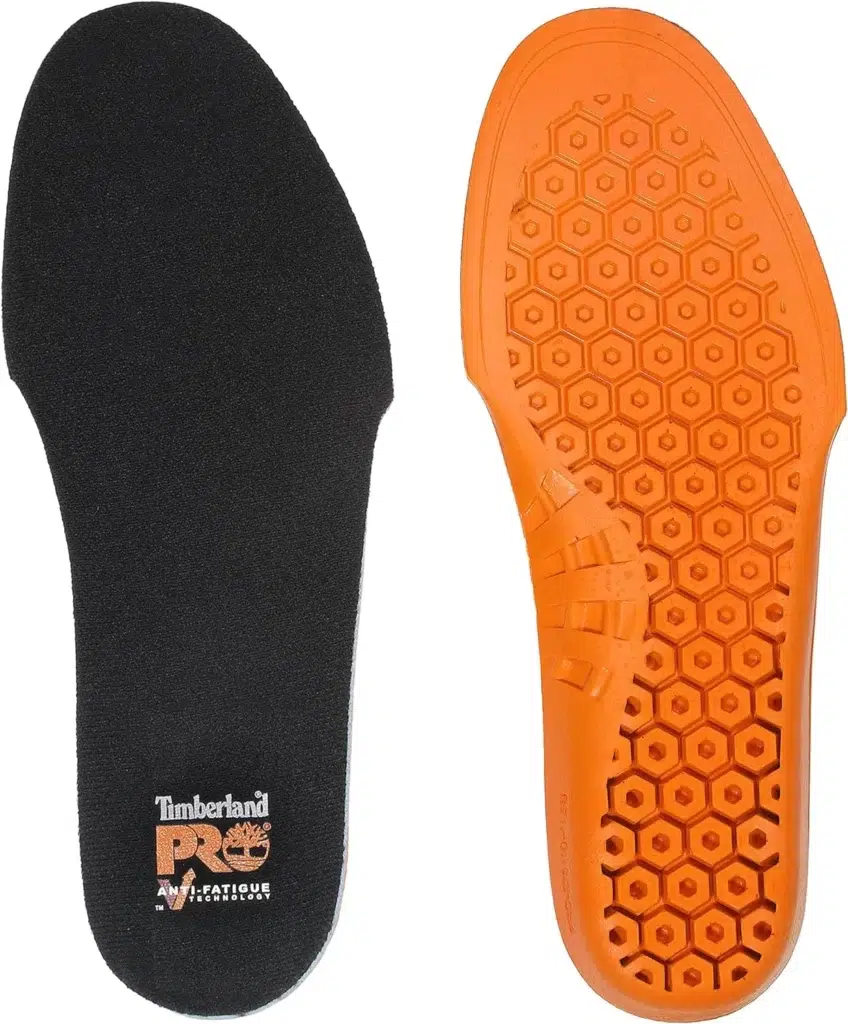
Timberland PRO Men’s Anti-Fatigue Insoles is known for its medically-oriented design. It specifically targets pain associated with sciatica.
Timberland PRO Men’s Anti-Fatigue Insoles contain medical-grade polyurethane that enhances comfort and support, effectively mitigating sciatica symptoms. It does this by redistributing pressure and absorbing shock efficiently.
Pros:
Great comfort and support
Assists in maintaining proper foot alignment
Excellent in distributing pressure evenly
Cons:
The more medical design may not suit every user’s preference
May take a few days to get used to.
Tips to Get the Most Benefit from Your Insoles
Fit is critical: Make sure your insoles are the right size. They should fit correctly in your shoes without moving around. Your feet shouldn’t feel cramped.
Switch between multiple pairs: Consider purchasing two pairs of insoles that you can alternate between. This can extend the lifespan of each pair. It ensures they have ample time to regain their shape between uses.
Don’t ignore your pain: Insoles can certainly help relieve your discomfort, but they’re not a miracle cure. If you find that your sciatica pain isn’t improving or is worsening, don’t hesitate to seek guidance from a healthcare professional.
Exercise and stretch: Insoles are only part of the solution to manage your sciatica pain. Regular exercise and stretching can significantly contribute to mitigating sciatica symptoms.
Last Thought
In conclusion, sciatica is a symptom of an underlying health problem. It brings discomfort that affects daily routines. The excellent news comes in the form of good footwear. Particularly insoles bring substantial relief to those suffering from sciatica. Insoles, when used as part of a comprehensive management strategy, can ease sciatica pain. They improve body alignment, absorb shock, and minimize lower back strain.
Insoles are not a cure for sciatica. However, they can help people with sciatica continue everyday activities without discomfort. The selection process requires careful consideration of support, comfort, material, and fit. Other critical factors are also important for effectiveness and comfort. Pairing insoles with regular exercise can lead to substantial progress in managing sciatica. Also, being open to professional health advice is helpful. Ultimately, the right insoles are more than footwear accessories. They are tools that enhance mobility and quality of life.







